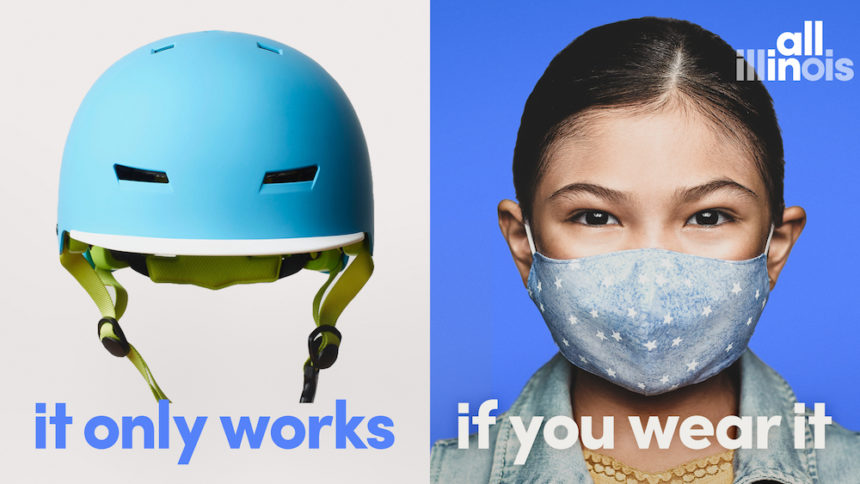Despite agreement among health experts about the effectiveness of masks to prevent the spread of COVID-19, asking people to wear them can sometimes backfire.
Before the state of Illinois launched its official mask wearing campaign, it conducted in-depth research with Civis Analytics to ensure the messaging wouldn’t have the opposite effect.
Civis designed a randomized controlled study of five potential campaign messages and surveyed more than 2,400 people in Illinois about them. The messages included comparing masks to other safety objects like helmets, preventing a second wave, wearing a mask to get out of the house, protecting family from COVID-19 and focusing on the 85% of studies that agree masks prevent virus spread.
The message that won out, by far, was comparing masks to other safety objects like helmets and seat belts.
“Just like every aspect of our coronavirus response, this campaign is rooted in science and data,” said Alex Hanns, deputy press secretary for Illinois Governor J. B. Pritzker. “This survey showed when it comes to mask usage, we have the most work to do with younger residents and those living in rural parts of the state. We also identified the most effective message: a mask is like a seat belt, a helmet or anything that keeps us safe – it only works if you wear it.”
The survey broke participants into six groups, one for each campaign message and one control. They showed each group a campaign message and then asked how likely they were to wear a mask next time they went out.
The comparison campaign had the largest gain in the likelihood to wear a mask over the control group, three percentage points. The other four messages had either no effect or a slight negative effect.
This type of study is better than the typical A/B message testing at determining which message is more persuasive, said Haleigh Miller, a senior solutions architect at Civis Analytics who worked on the study. She explained that people are good at picking the message they like best, but not at determining which message is more persuasive.
“One thing we tend to see with message tests like this, particularly when you’re talking about a topic like COVID, masks or even things like healthcare or taxes, people tend to have very firmly set opinions on it and it’s very difficult to move the needle,” Miller explained. “Talking about something like introducing a new brand or product that people know nothing about, we’re going to see much larger treatment effects because people don’t have a prior opinion on it.”
The study also identified potential areas of backlash. The message about 85% of studies agreeing masks are effective had the largest backlash potential, followed by the “wear a mask to get out of the house” campaign.
“Our outcome question was how likely are you to wear a mask next time you go outside,” Miller said. “We want people to say ‘yes, we’ll wear a mask,’ but if we get people saying no, particularly if that is more frequent among people who saw the messages than in the control group, that means one of these messages moved people in the opposite way.”
Civis and Illinois also identified areas where the campaign had the most work to do, breaking out the questions by age, location, gender and race.
Rural respondents were least likely to always wear a mask when leaving their home, with 32% saying they sometimes wore a mask when leaving home in the past seven days and 14% saying they never did. Younger people, between 18 and 34, were also less likely to always wear a mask, with 24% sometimes wearing one and 8% never wearing one.
The study also tried to identify the barriers to wearing a mask among those who didn’t always wear one. The two highest reasons were that a mask was not required where they went and that it was their freedom of choice not to wear a mask.
The resulting campaign, It Only Works If You Wear It, began this month. Hanns said the effort is being pushed out across broadcast, cable, connected TV, streaming audio, radio, billboards, digital display and video and social media.
The campaign compares masks to bicycle helmets, seat belts, car seats, football helmets and life jackets.
“Hundreds of studies prove their effectiveness, but how we talk about masks matters if we want to change people’s behavior and save lives – our ultimate goal,” Hanns said. “Building on the success of decades of public awareness campaigns, our effort presents a commonsense comparison between masks and everyday safety objects, which we will promote on every media channel imaginable.”







